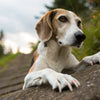How Long Does It Take Dog Hair to Grow Back? Understanding the Regrowth Process
- Houndsy
Table of Contents
- Introduction
- Understanding Dog Hair Growth Cycles
- The Risks of Shaving
- Caring for Your Dog's Coat During Regrowth
- Conclusion
- FAQ
Introduction
Have you ever wondered what happens to your dog's coat after a shave or a trim? As pet owners, we often face the dilemma of grooming—deciding when it's time for a haircut and how it might affect our furry friends. A staggering number of dog owners are unaware of the intricacies involved in dog hair regrowth. Did you know that factors like breed, age, and health can significantly influence how long it takes for your dog's hair to grow back?
In this blog post, we will explore the fascinating world of canine coat regrowth. By the end, you will have a comprehensive understanding of how long it takes for dog hair to grow back, the factors influencing this process, and how to care for your pet’s coat during this time. We will delve into the implications of shaving, the importance of proper grooming, and discuss what you can expect in terms of hair texture and appearance as it grows back.
So, let's embark on this journey together and ensure our beloved pets enjoy a healthy coat and a comfortable life!
Understanding Dog Hair Growth Cycles
Dog hair growth is not a simple process; it follows a cycle that can vary significantly from one breed to another. Understanding this cycle is crucial for pet owners, especially when it comes to grooming and caring for our dogs.
The Hair Growth Cycle
The hair growth cycle consists of three main phases:
-
Anagen Phase: This is the active growth phase when the hair follicles are producing hair. Depending on the breed, this phase can last from several weeks to a few years.
-
Catagen Phase: This transitional phase lasts a few weeks. During this time, the hair stops growing and detaches from the hair follicle.
-
Telogen Phase: The resting phase can last several months. After this period, the hair will shed, making way for new growth.
The duration of each phase can vary based on several factors, including the dog's breed and overall health. Larger breeds often have longer growth cycles compared to smaller breeds.
Factors Influencing Hair Growth
Several factors can influence how long it takes for dog hair to grow back after being shaved or trimmed:
-
Breed: Different breeds have varying coat types and growth rates. For instance, double-coated breeds like Golden Retrievers or Huskies may take longer to regrow their outer coat compared to single-coated breeds like Poodles.
-
Age: Younger dogs typically have faster hair growth compared to older dogs. As dogs age, their hair growth can slow down, resulting in longer regrowth times.
-
Health: Dogs with underlying health issues, such as thyroid problems or hormonal imbalances, may experience delayed hair regrowth. Nutrition also plays a vital role; a well-balanced diet can promote healthy skin and coat.
-
Season: Seasonal changes can impact coat growth. Many dogs shed their fur in the spring and fall, which can affect the regrowth process.
How Long Does It Typically Take?
Generally, after a dog is shaved, you can expect the following regrowth timelines:
-
Initial Growth: In the first few weeks, you may notice some fuzziness as the hair starts to grow back. Most dogs will start looking "fluffy" again within 2-3 weeks.
-
Partial Regrowth: It can take about 2-3 months for the hair to regrow significantly, but this can vary widely. Some breeds may take longer to reach this stage.
-
Full Coat Regrowth: For many dogs, it can take anywhere from 4 to 12 months for the coat to fully regrow to its original length, texture, and appearance.
The Risks of Shaving
While some pet owners might think that shaving their dog's coat is a quick way to manage shedding or keep cool in the summer, this practice can have unintended consequences.
Effects on Double-Coated Breeds
For double-coated breeds, shaving can disrupt the natural insulating properties of their fur. The outer coat protects the inner coat, which helps regulate body temperature. Shaving can lead to:
-
Heat Regulation Issues: Without the protective coat, dogs may struggle to maintain a comfortable body temperature, especially in warmer months.
-
Skin Damage: Shaved skin is more vulnerable to sunburn and irritation, which can lead to long-term skin issues.
-
Alopecia: In some cases, frequent shaving can result in patchy hair regrowth or permanent alopecia, where certain areas of the coat fail to grow back.
Alternatives to Shaving
Instead of shaving, consider these alternatives to maintain your dog's coat while ensuring their comfort:
-
Regular Grooming: Regular brushing can help manage shedding and keep your dog's coat healthy without the need for shaving.
-
Deshedding Tools: Specialized deshedding tools can help remove loose fur and reduce mats while allowing the coat to grow back naturally.
-
Professional Grooming: If your dog’s coat is matted, consult with a professional groomer who understands the breed's specific grooming needs and can provide a cut that maintains the coat's integrity.
Caring for Your Dog's Coat During Regrowth
As your dog's hair grows back, proper care is essential to ensure healthy regrowth. Here are some tips to support your furry friend through this process:
Maintain a Balanced Diet
A high-quality diet is crucial for healthy hair growth. Ensure your dog is receiving the right balance of nutrients, including:
- Proteins: Essential for hair structure.
- Omega Fatty Acids: Help promote healthy skin and fur.
- Vitamins: Particularly B vitamins, which can support overall coat health.
Regular Grooming
Even during the regrowth process, regular grooming should continue. Here’s how to do it effectively:
-
Brush Regularly: Use a soft brush to remove loose fur and prevent mats from forming. This is especially important for long-haired breeds.
-
Bathing: Bathe your dog as needed, but avoid over-bathing, which can strip natural oils from the skin. Use a gentle, moisturizing dog shampoo.
-
Check for Skin Issues: Regularly inspect your dog's skin for any signs of irritation, redness, or abnormal growths. If you notice any issues, consult your veterinarian.
Monitor for Changes
Keep an eye on how your dog's coat is responding during the regrowth process. If you notice any unusual patterns, such as uneven regrowth or bald patches, consult your vet.
Conclusion
Understanding how long it takes for dog hair to grow back is crucial for every pet owner. With the right knowledge and care, we can ensure our dogs have healthy, beautiful coats that enhance their well-being. Remember that factors like breed, age, and overall health all play a role in the regrowth process.
As you reflect on your own pet's grooming routine, consider how the Houndsy Kibble Dispenser can simplify feeding time, allowing you to spend more quality moments with your furry friend. By investing in your dog's care, from their diet to grooming routines, we contribute to their happiness and health.
For more information on elevating your pet's feeding experience, check out our Houndsy Kibble Dispenser.
FAQ
1. How long does it take for dog hair to grow back after being shaved?
- Generally, it takes about 4 to 12 months for a dog's coat to fully regrow, depending on various factors like breed, age, and health.
2. Will my dog's coat grow back the same as it was before?
- While most dogs will have their coat grow back, some breeds may experience changes in texture or color, especially if they are frequently shaved.
3. Is shaving my dog a good idea?
- Shaving is not recommended for all breeds, particularly double-coated ones, as it can disrupt their natural insulation and lead to skin issues.
4. How can I support my dog's coat regrowth?
- Maintain a balanced diet rich in proteins and omega fatty acids, and ensure regular grooming to help support healthy hair growth.
5. What should I do if my dog's hair isn't growing back?
- If your dog's hair is not regrowing or if you notice bald patches, consult your veterinarian to rule out any underlying health issues.
By understanding these elements, we can better care for our pets and ensure their grooming experiences are positive and healthy.












